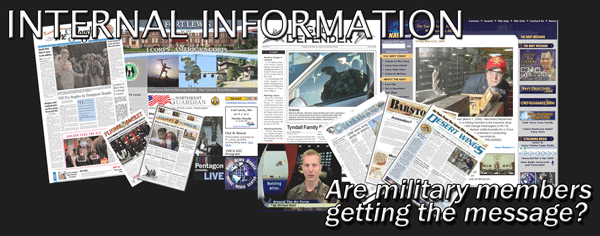Though there are cultural differences among the branches of service, the purpose of internal communications remains standard for all branches. Internal communications are the commander’s means of informing and receiving feedback from those under their command.
Therefore, commanders need to understand how service members use internal communications to better serve their needs through more effective targeting of messages in their internal communication efforts.
This study examined the uses of internal communication forms among active duty military personnel as measured dimensions through the lens of uses and gratifications theory. The experiment also collected data on attention and use of non-military media. Finally, we studied attitudes of military personnel about base newspapers.
Our first prediction was information seeking gratifications for possible online base newspaper use would be positively related to information seeking gratifications for printed base newspapers. The hypothesis was supported. We also questioned what level of gratification participants would report for the commander’s access channel and internal websites and found these two communication forms provided extremely limited gratification, regardless which of the five dimensions was measured.
We next measured the entertainment dimension predicting base newspapers, whether in print or online form, would provide high entertainment gratification, and internal websites and the commander’s access channel would provide no entertainment gratification. Base newspapers in either form provided only moderate entertainment gratification as demonstrated by the means of 3.10 and 2.43, respectively, on a 7-point Likert scale. The latter prediction, however, was supported as demonstrated by means of 2.17 and 1.53, respectively, for entertainment gratification. Essentially, we found active military personnel do not use any of the internal communication forms for entertainment.
We did not find support for our prediction online base newspapers provide high decisional utility as demonstrated by a mean score of 2.84.
We found only partial support for our prediction base newspapers, the commander’s access channel, and internal base websites would have limited decisional utility. In essence, none of the four measured forms of internal communications provided more than moderate decisional utility as demonstrated by the high mean of 3.21 on a scale of 1-7 for base newspapers.
We next measured interpersonal utility gratification as it pertained to the printed base newspaper, online base newspaper, the commander’s access channel, and the base internal website predicting all but the internal website would provide moderate gratification. Our prediction was partially supported in that interpersonal utility was moderately gratified by the base newspaper in both printed and online form.
However, the base internal website did provide moderate interpersonal utility.
We also questioned to what extent parasocial interaction would be gratified for each internal communications form. Means, by form of communication, ranged from 1.64 to 3.13 on a 1-7 scale. This clearly demonstrates the need for parasocial interaction was only very modestly gratified by any internal communication form, although the newspaper, in both forms, provided the highest gratification among them.
In measuring exposure and attention to different forms of communication, we found military personnel were moderately exposed to all forms of communication as demonstrated by mean scores on a 1-10 scale which ranged from 2.97 for radio talk shows to 7.48 for television news. These findings conflict with the much lower scores found in uses and gratifications measures for military media. This means although military members are being fairly well exposed to communication forms, these forms are not, overall, gratifying their needs.
The overarching purpose of this study was to measure how people use the base newspaper and their attitude toward it. We found age and the uses and gratifications dimension of decisional utility were useful in predicting attitude toward the base newspaper. We also found older military members had more negative attitudes about the base paper and no one used it for decisional utility.
Limitations
Generalizability. Most poignant to an analysis of the generalizability of this study’s findings is an evaluation of sampling methods. This study’s convenience sample was drawn from across the Department of Defense, but the vast majority of respondents were Air Force. Some might argue this convenience sample, response source, and rate might not allow generalizability to the Defense Department population sought to be generalized to. Less than 10% of the total military population responded, which would have been ideal. We also would like to have seen at least 5% of each service branch’s population respond.
Timing. Due to the condensed nature of the course for which this study was conducted, time constraints were presented throughout the study which may have negatively affected response rate. The survey was open for six days. A period of at least a month would have been preferred to allow for follow up and multiple announcements of the project to be disseminated.
Scale. Throughout the data, no response on our 1-7 Likert scale was higher than 4.07. Internal communication forms are not meeting all of the dimensions of uses and gratifications. The lack of mean responses closer to 7 indicates we still do not understand how people are using these communication forms, even though exposure and attention rates are significant.
Future Directions
The finding military members are well exposed to internal communication forms but their needs are not gratified by them points to a need to study the efficacy of internal communication forms. Perhaps a future survey could come straight out and ask whether, how, and why military members use each form of internal communication could shed light on whether these current forms are viable and effective.
BACK TO TOP
